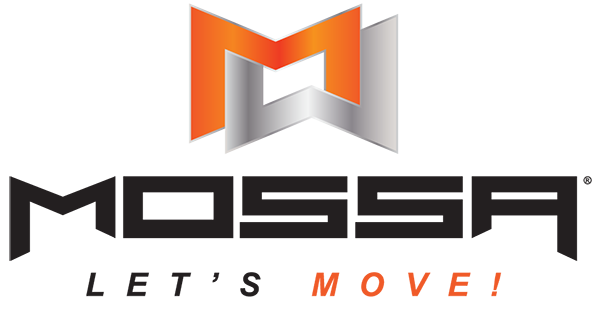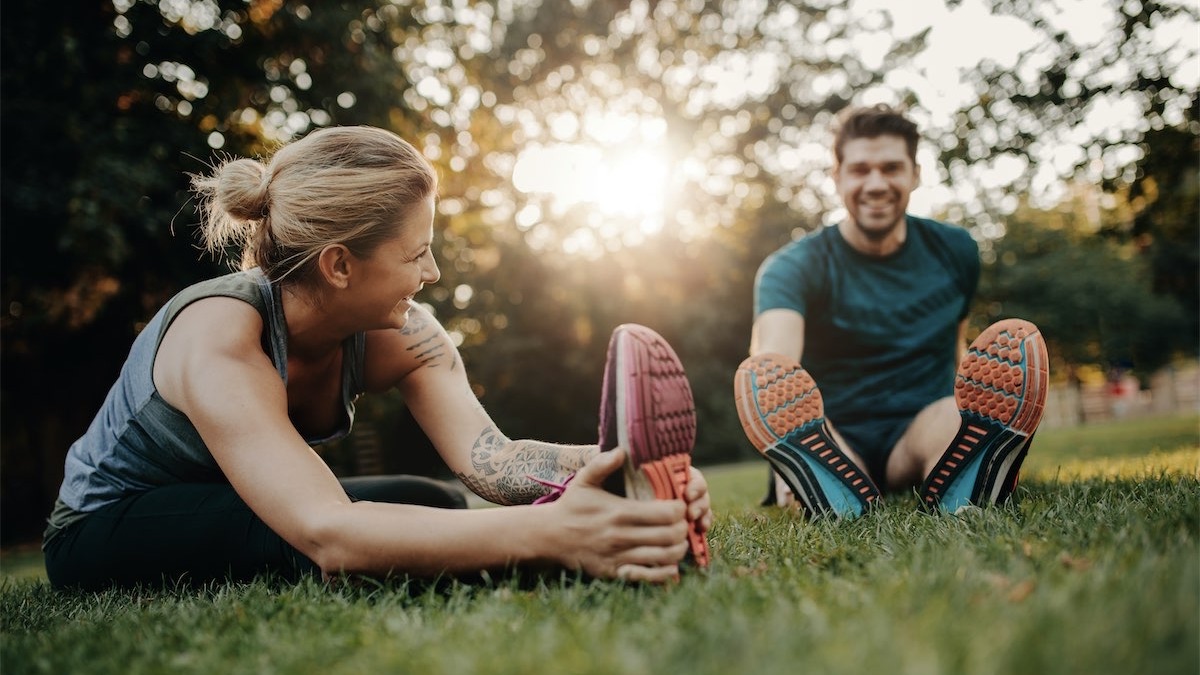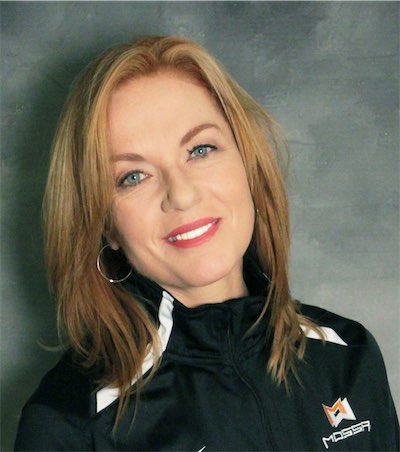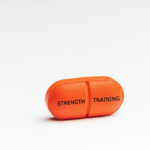“I’m just asking for a friend,” said the woman sitting next to me on a recent flight back to Atlanta. “How does someone get started with exercise?”
Like many fitness professionals, I have been asked this question a gazillion times. My response is a mix of science, but also, simply, years of observation. There isn’t a one-size-fits-all way to start exercising, but there are a few great options out there (of course, I am biased to our options). In contrast, there are some popular workouts that aren’t beginner-friendly, so much of my advice is reverse engineering the many things I have seen people do, let’s just say, unsuccessfully.
I like to borrow from the author of Good to Great, Jim Collins’ metaphor of the gigantic flywheel. Imagine that making exercise a habit is like pushing this massive flywheel. At first, we push with a tremendous amount of effort, and it moves imperceptibly at first. You stay consistent and finally the flywheel does one full revolution. But then, with persistent effort, the flywheel slowly builds speed and momentum and turns again. As Collins says, “then at some point – breakthrough! The momentum of the thing kicks in your favor…its own heavy weight working for you.” This is the moment when exercising finally becomes a habit.
But let’s go back to the beginning and answer her question on how to start a workout routine. Here are 10 things that I believe are incredibly helpful getting the physical flywheel turning!
1. Know Your Why
Having a compelling reason why you want to start working out is crucial for long term success. Is it to live longer, to be more active, to easily play with your children, to feel better in your body, to manage stress better, to sleep better? And it’s okay if “I want to look better” makes your list. Define your reasons why you want to start exercising, make them compelling, own them, marinate in them. When times get tough, and your ‘motivation muscle’ is waning, you’ll be able to fall back on your why to set you back in motion!
2. Set an Implementation Intention
In James Clear’s remarkable book, Atomic Habits – a highly suggested read by the way – he highlights the importance of Implementation Intention when it comes to creating habits. This means that you plan beforehand when, where, and how you are going to accomplish something. We’re early in our list, so you may not yet know the when, where, and how you’ll get started working out, but leave space near your why, and come back to clearly state when, where, and how you’ll start exercising.
3. Don’t Miss Monday
In psychological science there is a phenomenon called the fresh start effect, which shows that people are more likely to follow through on their goal setting on more meaningful dates, such as the start of a new week or financial quarter, a birthday, or a holiday. This explains why so many people commit to working out and getting in better shape each new year. These “temporal landmarks” encourage us to step back and evaluate our current situation. And when we do this, we gain the stimulus to move forward and be better, we become more driven and productive, and we overcome the lack of motivation to work out.
4. Make It Easy
Another one of James Clear’s tips on habit formation is to make it easy for yourself. It’s all about removing barriers.
Here are a few ideas to consider:
If you are new to working out, or re-starting after time away, start small. Doing too much too soon usually results in too many negative physical sensations and/or a sense of overwhelm, which is a recipe for dropout. Choose accessible, easy beginner exercises, like the MOSSA On Demand 10-minute workouts, which are a great place to begin creating a movement habit. These beginner-friendly workouts are not physically overwhelming; they teach us to walk before we run.
Schedule your workout plan appropriately. Ask yourself – seriously – when would you be most likely to do it? It is of no use to force yourself to get up early in the morning if you are not a great morning person, because the cost to your motivation muscle is just too high.
Another idea: pre-plan your gear. What I mean is, if you plan to go to the gym, set out your clothes, shoes, and water bottle well in advance. And if you’re working out at home, have a place where your equipment is left out and ready to go. If your equipment is there, you’ve removed the “Do I have to set up before each workout?” excuse. Or, if you can’t leave it out around the clock, at least set it up the night before.
My trick, when I know I am working from home for the day, and I know I will be working out at home, is that when I get dressed in the morning, I just get dressed in my workout gear. This sets my intention of working out during my scheduled time slot.
5. Make It Satisfying
James Clear tells the story of giving toothpaste a minty taste to make teeth brushing satisfying. We are so used to the refreshing flavor when brushing our teeth, it seems weird to think that at some point it wasn’t minty.
When it comes to movement, we at MOSSA have done everything we can to make exercise more palatable. One of the ways is through the driving force behind our group fitness workouts: the music. Music has been scientifically proven to improve performance. It can also enhance our mood and delay feelings of fatigue.
That’s why we recommend that our partner facilities invest in great sound systems, to create an inspiring and immersive musical environment. At home, you don’t need a massive SONOS or BOSE sound system, but there are a lot of portable speakers that can provide an environment that moves you both literally and figuratively.
We also know for sure that the right equipment makes a huge difference. A step, an adjustable barbell, the ViPR PRO, a proper indoor bike…these are all designed for comfort, ease of use, and better results. When the equipment is quality, it means you get a quality workout – and a quality workout is a lot more satisfying! As many a wise person has said, “Your health is an investment, not an expense.”
6. Track It
Research has shown that, when people start working out, those who track their habits are more successful at reaching health and fitness goals, versus those who don’t. I am not talking about tracking metrics like calories, steps, heart rate, etc. Those things are a different beast. The tracking I am talking about is a simple question: did you move today? Yes or no. The process of habit tracking, whether you write it down, express it to a family member, or check it off your to-do list, helps to create self-awareness and accountability and can be a strong motivator as you see progress. It might take a little getting used to, and trial and error to find your own best method, but it will make a difference in creating a healthy exercise habit.
If you need help with a workout plan – something you can track and boxes you can check off – sign up to receive our free monthly MOSSA calendars. We created them as a super simple way to track your movement each week, either 3, 4 or 5 times per week.
7. Change Your Self-Talk
Ok. Bear with me as I throw a little psychology your way. The way we talk to ourselves can have both a positive and negative effect on our health. While more research needs to be done, it has been shown that positive self-talk, or optimism, can have many health benefits, such as increased life span, lower rates of depression, higher immune function, better wellbeing, and improved cardiovascular health.
Unfortunately – and especially for beginners getting started working out – negative self-talk is common. But sometimes just a subtle shift in approach can make all the difference.
Here are some examples:
Saying, “I HAVE to work out,” makes it sound like a chore. When we say, “I GET to work out,” it is like an amazing privilege that this body we own can do this remarkable thing.
“I can’t do that, I’ve never done it before,” can be replaced by, “I am excited to try something new because, no matter what, I will have challenged my body and brain in a new way.”
“That wasn’t a great workout,” can be replaced by, “Every single time I move, something great is happening to my mind and my body.”
“I’m terrible at this,” can be replaced by, “Every time I am struggling to learn something, I am building a better brain and my body is learning to do something new.” Or one of my favorites is, “If it doesn’t challenge me, then it doesn’t change me.” Or, simply, “I’ll get better at this.”
“I hate doing this movement,” can be replaced by, “This isn’t my favorite movement, so there must be something in this that my body needs.”
8. Block Out the Noise
The fitness industry makes a cacophony when it comes to what’s the best X to achieve Y. I have seen time and time again people getting more caught up in the “perfect” type of exercise, rather than just “exercise” alone. So much so that the information becomes disempowering, rather than empowering.
Case in point, the best exercise for you isn’t HIIT or Pilates, or yoga, or some other “perfect exercise for building a stronger core.” The best exercise for you is the one you will stick with, and the one you can learn to enjoy and turn into a healthy movement habit.
9. Find an Accountability Buddy
Research has shown that publicly committing your goals to someone gives you at least a 65% chance of completing them. However, having a specific accountability partner increases your chance of success to 95%.
Your accountability partner might be a friend, a family member, or anyone who is looking to achieve similar goals. Maybe you can schedule to do the same workout at the same time, or even better, together in person. Or it could be joining a Facebook Group like MOSSA On Demand Fans and Friends – a whole community of accountability partners.
10. Celebrate Small Successes
It’s probably in our nature to focus on the “big goal” and, with exercise, those goals take time. But celebrating the small wins along the way sparks the reward circuits of our brains and releases chemicals that give us a feeling of pride and a happiness factor, making us want to go further towards our next achievement. Small wins could be physical, like getting one more rep done or lifting something heavier in Group Power or feeling more coordinated in 3D30 or finally getting more mobility in the hips during Centergy. The small wins might be psychological, such as having a greater sense of wellbeing, sleeping better, feeling gratitude for simply being able to move, or hitting your weekly movement goal. All these small wins are worth celebrating. Glossing over them, or not paying attention to them can set us up for failure, because those big goals can seem so elusive.
Hopefully some of these small tips can help you start working out, whether your goal is to build muscle, improve your heart health, or simply to get moving and start getting in shape. Take one or two of the ideas for a test drive and reap the rewards of some scientifically proven strategies to help you get moving and keep moving.
…
MOSSA’s mission is to inspire people to move. We create and deliver innovative and inclusive workouts for health clubs and YMCAs worldwide and for the home user through MOSSA On Demand.
As a small thank you for visiting our blog, use the coupon code THANKYOU30 for an additional 30 days to get started and get moving with MOSSA On Demand.



 More than Muscles: Benefits of Strength Training
More than Muscles: Benefits of Strength Training New Member Onboarding: Over-Welcoming or Overwhelming?
New Member Onboarding: Over-Welcoming or Overwhelming? Team vs. Technology and the Future of Fitness
Team vs. Technology and the Future of Fitness Setting Goals for Group Fitness
Setting Goals for Group Fitness Does Exercise Have to be Boring and Bitter?
Does Exercise Have to be Boring and Bitter?